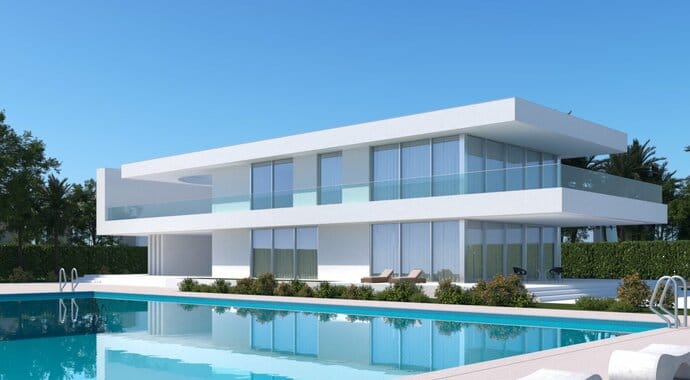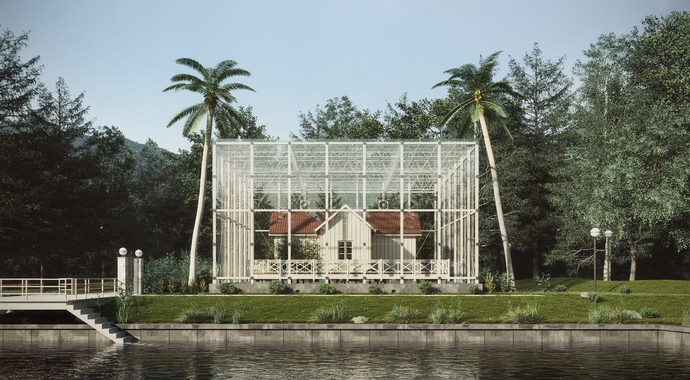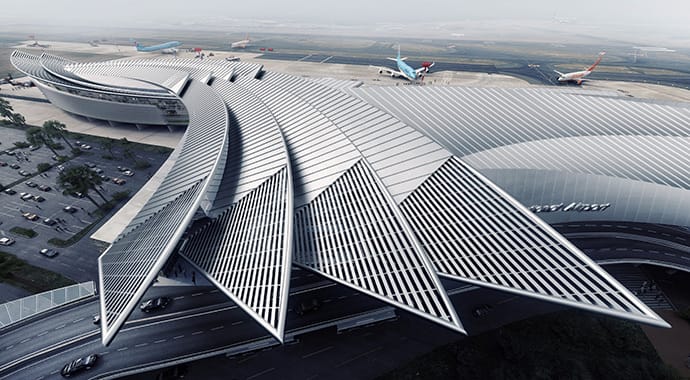The kitchen is not just a place for cooking; it's the heart of the home, where technology meets tradition. Learn how V-Ray can turn up the heat on your designs.
Creating realistic kitchen renderings is a crucial step in the design process, offering both clients and interior designers a window into the potential of their dream kitchen that no floor plan can deliver. Through high-quality, photorealistic 3D renderings, clients can visualize the final design during the design process, enabling informed decisions about the physical space that will align with their vision and requirements.
Introducing V-Ray: the art of photorealistic renderings
Enter V-Ray, a powerhouse rendering engine renowned for its ability to produce high-quality, photorealistic images. With V-Ray, designers and architects can work together closely and bring their kitchen concepts to life with detailed previews of architectural projects and ideas even before a single tile is laid, showing a realistic view of the available space, the different layouts, furniture, doors, fixtures, appliances, cabinetry and storage solutions, countertops, and more features that create the perfect kitchen for all your needs.
But how do you create the perfect kitchen rendering? This article provides valuable insights and techniques for crafting stunning kitchen design renderings using V-Ray, turning ideas into visual masterpieces.

Prepare your kitchen model
The foundation of a great rendering lies in project preparation. Collecting high-quality 3D models, textures (check out Chaos Cosmos' extensive library and user-friendly interface), and resources is essential for successful 3D renderings and the interior design itself. When setting up your 3D scene in V-Ray, importing models and organizing your workspace efficiently paves the way for a smooth rendering process no matter how complex the project of your future kitchen is.
- Clean up your geometry: Depending on where your models were made, their geometry can become a little challenging to render. When importing assets, always check their geometry for overlapping faces and vertices, clean unwanted smoothing groups, and make sure everything is tidy. From a simple counter space to more complex light fixtures, clean, coherent geometries are much easier to render, and you’ll be glad you took the time to do it.
- Optimize textures: Do not use unnecessarily large textures. Most commercial material libraries feature really high-quality textures, with maps ranging from 2k to even 8k. Although these look really good, they also take a hit at your computer’s memory, and while that might not be a problem if you have plenty of RAM available, when using GPU rendering it can cause issues. Luckily, there’s usually no need for huge textures, and you can get away with just 2k. Then, for those occasions you really need to use a gigantic texture, V-Ray can handle it just fine with intelligent texture management.
- Manage scene complexity: Kitchen appliances are probably an object category on its own. The more, the better, and they are always super detailed, colorful and full of glossy reflections. That’s a designer’s dream, but also a renderer’s nightmare as your kitchen scene will most likely be filled with all sorts of objects, leading to a very high memory usage. That’s why it’s so important to always keep an eye on your scene’s complexity, avoiding unnecessary details (you don’t need to fill your closed drawers with actual silverware, believe me) and using V-Ray proxies as much as you can. Another good idea is to separate the kitchen from the rest of the building if you can't see the rest of the house from the new kitchen in real life. If the eyes can’t see, the renderer can’t feel, and that might be just the difference between good renderings and very high quality renderings.
These are the main things you need to do to ensure your model is perfectly primed for rendering.
See how artists are using V-Ray in interior design.

Consider kitchen lighting
Lighting can make or break a rendering. Simulating natural lighting can infuse your kitchen scene with a sense of realism and warmth. V-Ray offers a plethora of artificial lighting options, from accent lights under cabinets to pendant lights over islands, each adding depth and dimension to your design.
Since every light source is different, V-Ray offers many different ways to create them, with some advanced tools to make sure you get exactly what you need:
- Area lights: real lights have real surface, which means that their effect on the scene depends on their shape and size. Using VRayLights is the perfect way to represent real lights as you have full control over their size, shape (rectangles, spheres, disc, mesh), falloff angle, color temperature, intensity, decay… The list goes on! From LED tape under kitchen cabinets to incandescent spotlights on the ceiling that create a moody look, passing by the tiny lights that you see in small appliances on a countertop or kitchen islands, you can do pretty much anything an interior designer might wish for.
- Natural light: people absolutely love natural light in their kitchen. Even if the sun is not directly coming from the windows or a skylight, the soft light that comes from outside is always desirable and should always be used. V-Ray’s Sun/Sky system is the perfect solution to that, as it’s easy to use and extremely realistic, not to mention fully controllable (you can even control how clouds will look and if they cast shadows on the scene using an easy to use interface, which is simply wicked).
For more lighting tips that boost photorealism, explore the Chaos Blog.
Select textures and materials
Choosing the right textures and materials is vital in a photorealistic rendering. Whether it’s stainless steel's sleekness or wood's warmth, each material needs to reflect reality.
You can use pre-made materials from Chaos Cosmos’ library, Chaos Scans’ extremely realistic scanned materials, or start creating your own materials from scratch with handy presets that give you the first push.
V-Ray’s material editor is a powerful tool, allowing for the customization and application of materials with realistic effects such as reflectivity and roughness. Besides the material editor’s preview window, you can also use V-Ray's powerful IPR to iterate through different settings and find the perfect look for your materials according to your scene and lighting. Model the space, add furniture, and start applying your materials.

Add the details
Details bring a perfect kitchen to life. Adding elements like utensils, appliances, and decorative items adds layers of realism to your space. Again, Chaos Cosmos is perfect for the task, with thousands of high-quality assets ready to render. It allows you to experiment with various possibilities to reach the desired look and feel quickly and effectively.
Finding the best camera angles for your project to really compliment the kitchen's layout and using depth of field effects can further enhance the authenticity of your renderings. Your kitchen is gorgeous, so it needs equally beautiful pictures to go with it. A few tips:
- It’s important that your 3D renderings convey the interior designers' intentions as clearly as possible without looking like a technical picture, as the feeling your image conveys plays a critical role in the final product . Show the kitchen as a whole, but also look for the best parts of it (usually the sink and the wall cabinets that contain the fridge are a must-see for all clients).
- There are usually a lot of details to see, so go to town and show them! Use depth of field to give that photographic look that always enchants the client for its realistic, beautiful images. A great project can be shown in detailed shots, so leverage elements like doors and flooring to make your kitchen look like an integral part of the house and not just an add-on.
For more on creating photorealistic renderings, check this guide out.
Advanced V-Ray techniques for interior designers
For those looking to push the boundaries, V-Ray offers advanced techniques for handling complex geometry and adding fine details. These techniques can elevate your kitchen design to new heights, from realistic carpets to intricate tile patterns.
Use V-Ray Fur to create realistic rugs and fabrics that breathe life into your scene: they have organic forms that create beautiful shadows and volumes, and the furry look always gives a cozy feel to any scene.
A good idea is also to use displacement to create fine details on surfaces like brick or tile walls, as well as for objects like food. This allows you to have very intricate details that scream “realism” and will definitely help selling your design.
Want to know more about creating the perfect kitchen rendering? Take a look at this series of tutorials.

Showcasing stunning 3D kitchen renderings
Highlighting a selection of kitchen renderings created with V-Ray can inspire and illustrate the range of possibilities, from sleek modern designs to cozy traditional settings. Each 3d rendering showcases different techniques, styles, and realism levels, proving the versatility of V-Ray in capturing the essence of kitchen design. Visit the Chaos Gallery for examples of stunning interior designs.
Conclusion
This guide has traversed the essential steps and techniques for creating breathtaking kitchen renderings with V-Ray. From meticulous preparation to the final touches to the space and detail, each step of the kitchen design process is crucial in the journey to realism. V-Ray offers the tools needed for photorealistic renderings and empowers designers to experiment and explore their next project, pushing the boundaries of creativity in many different kitchen designs. As we conclude, the potential of V-Ray in kitchen rendering is clear: it's a tool that brings design concepts to vivid life, enabling designers to craft spaces that resonate with beauty, functionality, and realism even before their construction.








